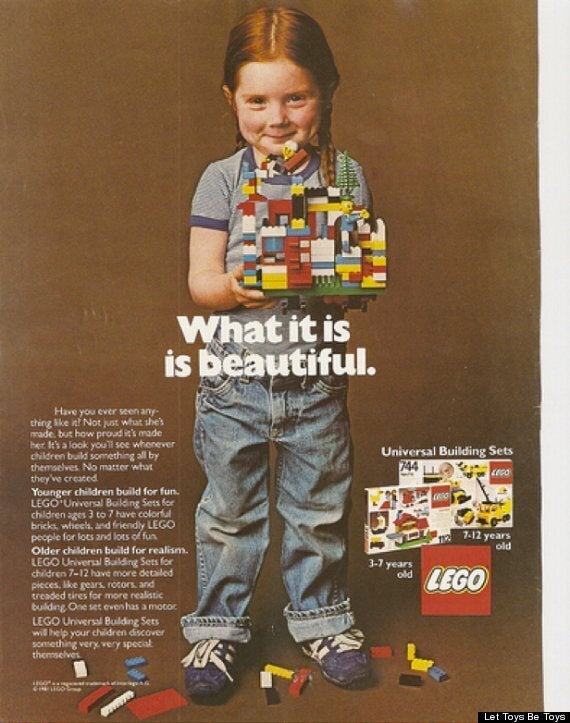Before entering Parliament I spent two decades working as a professional electrical engineer across three continents. Regardless of the geographic location or the size of the company it was always a predominately or all male environment. But it is only when I walk into a toy store that I feel I am really experiencing gender segregation.
At some point over the last three decades the toy industry decided that parents and children could not be trusted to choose to what to buy without colour coded gender labelling.
I say over the last three decades because as these photos brilliantly illustrate, there was a time when toys were toys and blue and pink were colours, not gender emblems.

Argos catalogue page from 1976 next to items Argos sells today

Lego advert from 1981, note the girl is wearing blue!
It's not that in the Eighties, Y chromosome was dyed blue or the X chromosome began secreting pink.
This aggressive gender segregation is a consequence of big company marketing tactics.
As every successful marketeer knows differentiation makes for greater profit margins and segmentation gives you a bigger market overall.
So with three-year-old girls only being able to 'choose' pink tricycles then the manufacturer can charge more for that special girlie shade with a premium 'Princess' saddle.
And of course that trike can't be handed on to a brother or nephew ensuring further sales of blue bikes with Action Man handlebars.
But what may be driving profit margins is limiting children's' choice - and experiences. And ultimately limiting the UK's social and economic potential.
The lack of women in science and engineering has long been a matter of concern to me. As I child I suffered from what I now call Marie Curie Syndrome - the inability to name more than one woman scientist. During my career in engineering I realised there were many different contributory factors keeping women out, from old fashioned sexism to parental preference for 'clean' professions.
After I was elected, campaigns such as Pink Stinks and Everyday Sexism focused my attention on the role of toys, then in 2012 I received a letter from a constituent about our local Boots:
The children's toys section in the basement categorises products by gender and displays signs saying "girls' toys" and "boys' toys" above the shelves.
This perpetuates gender stereotypes and subtly but powerfully shapes the thinking of children (and their parents), constraining their minds and stifling their full potential. It discourages boys from playing with dolls, and girls from playing with Lego.
Her concerns were upheld by a survey from Let Toys Be Toys, who found that half of stores used explicit 'Boys' and 'Girls' signs above shelves. They highlighted both the impact of these beliefs, attitudes and career choices - and the backlash by parents unhappy that their children's choices were constrained - and by children themselves, as this brilliant contribution from seven-year-old Charlotte makes clear.
When this government came into power one of the first things it did was to stop funding the UK resource centre for women, which sought to provide a coherent strategy to promote gender balance in STEM. It appeared to be their view that Government's role was to step back and let the market deliver - 'a rising tide raises all boats' as one Minister said to me.
When I started my engineering degree 12% of my peers were women; 30 years later the proportion of female engineering students has not increased at all. The market has not delivered.
I do believe there is now a more proactive view across both industry and government that this is not only an issue of social justice, it is a question of UK competitiveness. At 6% the UK has the lowest proportion of female professional engineers in the EU. India, a country with a significant gender literacy gap still manages to attract more women into STEM than we do.
Key political and social questions around climate change, genetically modified foods, healthy aging, have science and engineering at their heart.
It is not acceptable to lock out fifty per cent of our population from making their contribution.
I welcome Vince Cable's recent strong line on the subject, Tory MP Peter Luff's vigorous campaign for more female engineers and Elizabeth Truss's acknowledgement of the role of toys in putting girls off maths .
With such a cross party consensus and active campaigning organisations such as Let Toys Be Toys, Pink Stinks, Sciencegrrl and Everyday Sexism I have hopes we will see real change.
I was pleased that Let Toys Be Toys latest survey in November found only a fifth of stores using explicit gender labels - although 72% still used gender cues such as colour coding. In the US, anti-gender stereotyping toy company Goldiblox won a Super Bowl advertising slot in an open vote.
But I also hope my debate helps industry see the importance Parliament places on this issues and the likely consequences of continued gender stereotyping.
Newcastle Boots, by the way, have taken my constituents' criticisms on board.
